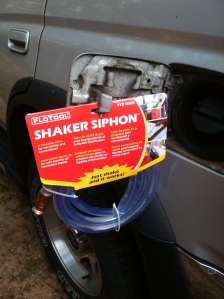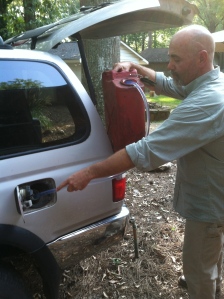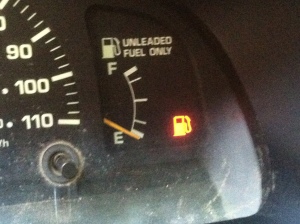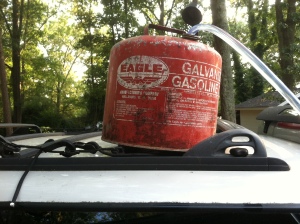Gasoline in your mouth is not pleasant – or safe!
This doesn’t happen – not to you!
Growing up on a rural farm there were times when we needed gasoline for our non-essential combustion engines (dirt bike or go-cart). Daddy would never notice a gallon missing from his work truck.
Our technique was crude. We’d stealth-fully shove a length of hose into Daddy’s plumbing truck gas tank and coax our youngest brother to suck on the other end of the hose if he wanted to ride to the bottom fields. The thing is, he wised up after his first mouthful of gas.
You have safer options today. Of course, in an extreme emergency, you could use a hose to siphon fuel orally, but it’s not advisable.
I purposely ran the tank of my daily driver below empty this week. A very rare occurrence. I needed to rotate my gasoline storage. The fuel was just over six months old. Though I treat my stored fuel, I don’t trust the ethanol mix to last. Corn gas isn’t good for your vehicle.
If you want real gas, here is a site to help you locate non-ethanol laced fuel near you. It’s more expensive but is so much better.
Siphoning Gas Without Sucking
First, let me say how much I hate Government Approved gas cans! The Usurpers on the Potomac screw up everything they touch. Even a simple gas container.
As of January 10, 2009 all portable fuel containers are required to conform to two new regulations:[3]
- They must meet new federal Mobile Source Air Toxic regulations, based on the California Air Resources Board’s regulations.[4]
- They must meet the requirements of the Children’s Gasoline Burn Prevention Act.[5] – Source
I suppose the switches, buttons and pouring handles on approved containers are for our safety, right? Well, they suck!
Okay. I’m better now.
To keep from sucking from Government cans, or any gas cans, you need a Shaker Siphon.

Just shake and it works!
You can purchase these online. I found this one at an auto parts store and bought two. They cost about 8 bucks a piece.
For my Forerunner, I have to elevate the gas can above the vehicle’s tank. Holding a 5 or 6 gallon tank of gas while filling your vehicle tank is not practical. I sit my on the top of the Forerunner or on the ledge of my turn signal with my backdoor open.

That’s me suspending a 5 gallon Jerry Can. Not really. It’s resting on my turn signal.
The hose is only six feet long. Keep that in mind for your can placement. When on the roof, I have just enough hose length to reach my vehicle gas tank.
A slight tilt allows the valve to suck more fuel from the can.
It would be much easier to place the can in the back of a pick up truck and just shake the hose. I’m truck-less at the moment.
Warning: If you place the tank on top of your vehicle, make sure you hold the hose in your vehicle’s tank as you shake the siphoning valve in the 5 gallon can. You may not have a decent length in the opening of your car’s tank. Shaking the valve end can pull the filling end out of the tank opening. There’s no shut off valve. The gas will pour all over the side of your vehicle and your shoes until you re-insert the hose into your tank.
Don’t ask me how I know.
This Shaker Siphon will drain a 5 gallon can of gas like it’s nobody’s business. A couple of minutes and you’re ready for the next transfer can.
This device is not limited to fuel transfer. It can be used to transfer water and other liquids. Just be sure to label clearly and keep different hoses separated to prevent cross contamination.
You’ll want to wear gloves (do as I say, not as I did) and have some Gojo on hand to remove any gas that may have spilled on your skin.
Consider adding Gojo to your vehicle kit.
No water needed. Just rub a dab of Gojo on your hands and wipe off with a towel.
My next gas siphoning project is to build a portable filling pump from a spare electric fuel pump. Just hook it up to your car battery and transfer fuel to another tank.
What’s your best method fuel (liquid) transfer? Share in the comments if you’d like.
Keep doing the stuff,
Todd




With only a hose and shy about sucking, the farmers technique works well. Submerse the hose into the fuel as far as possible while holding a fist around the dry end of the hose so that you can seal the hole of the hose with your thumb. Once fully submersed as far as possible to your fist, then tightly cap the hose end with your thumb. Slowly draw the hose out of the fuel so that two thirds of the hose is drawn. This length allows for the weight of the fuel to be drawn out of the hose through the open end and creates a vacuum to pull fuel. Lower the hose down below the fuel tank into the receptacle and remove your thumb. Fuel will flow out the open end.